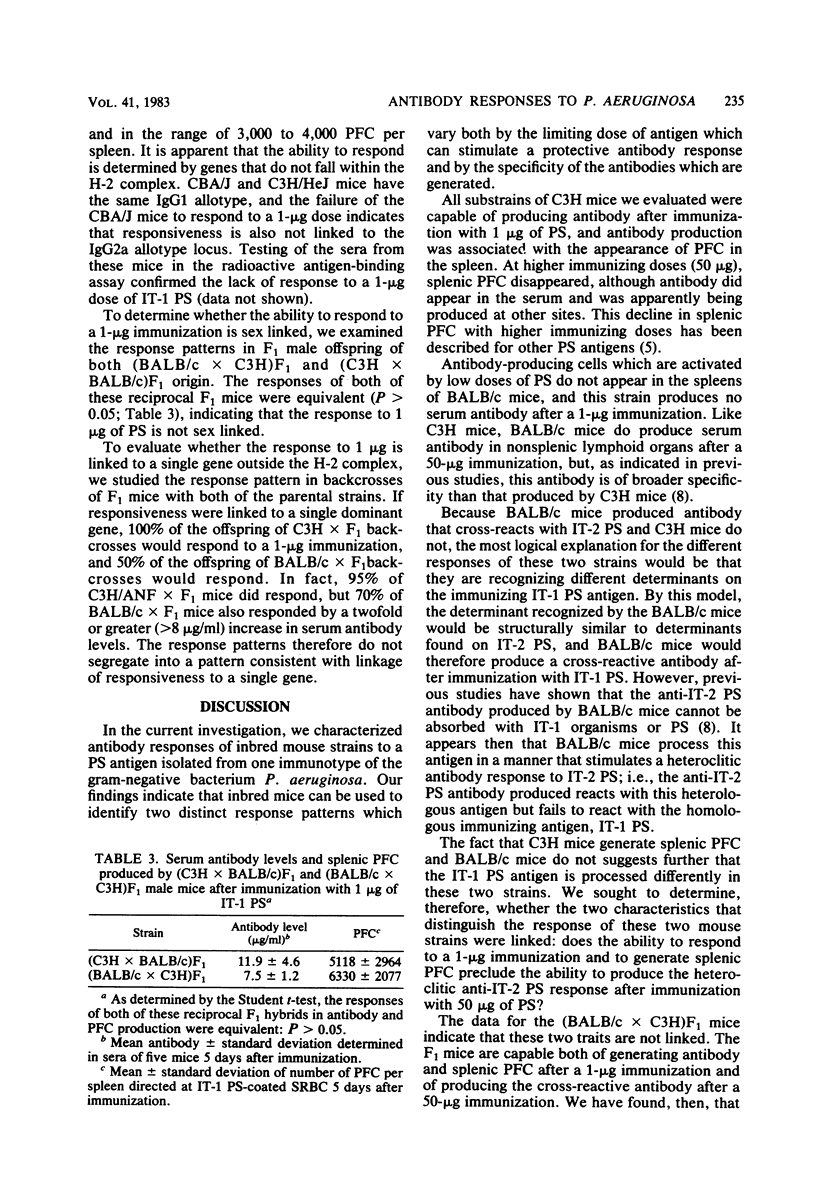Abstract
We explored the genetic basis for the differing immune responses observed in inbred strains of mice to a high-molecular-weight polysaccharide (PS) from Pseudomonas aeruginosa immunotype 1 (IT-1). Previous studies have shown that C3H mice immunized with this antigen produce only immunotype-specific antibody. BALB/c mice immunized with IT-1 PS produce both anti-IT-1 PS antibody and antibody cross-reactive with PS from P. aeruginosa immunotype 2 (IT-2). In the current study, we observed that, in addition, these two strains differ in their ability to respond to low immunizing doses of IT-1 PS. C3H mice generated a protective antibody response after a 1-microgram immunization, whereas BALB/c mice failed to produce protective antibody after receiving 1 microgram of PS. Both strains generated protective levels of antibody after a 50-micrograms immunization. Genetic analysis of these response patterns indicates that the ability to produce cross-reactive antibody and the ability to respond to a 1-microgram immunization are independently inherited traits. In addition, the responsiveness of C3H mice to a 1-microgram immunization with the production of protective levels of antibody is not linked to the mouse major histocompatibility (H-2) complex, to sex-linked genes, or to a single gene outside the H-2 complex.
Full text
PDF




Selected References
These references are in PubMed. This may not be the complete list of references from this article.
- Dunham E. K., Dorf M. E., Shreffler D. C., Benacerraf B. Mapping the H-2-linked genes governing, respectively, the immune responses to a glutamic acid-alanine-tyrosine copolymer and to limiting doses of ovalbumin. J Immunol. 1973 Dec;111(6):1621–1625. [PubMed] [Google Scholar]
- FARR R. S. A quantitative immunochemical measure of the primary interaction between I BSA and antibody. J Infect Dis. 1958 Nov-Dec;103(3):239–262. doi: 10.1093/infdis/103.3.239. [DOI] [PubMed] [Google Scholar]
- Markham R. B., Nicholson-Weller A., Schiffman G., Kasper D. L. The presence of sialic acid on two related bacterial polysaccharides determines the site of the primary immune response and the effect of complement depletion on the response in mice. J Immunol. 1982 Jun;128(6):2731–2733. [PubMed] [Google Scholar]
- Neter E. Pseudomonas aeruginosa infection and humoral antibody response of patients with cystic fibrosis. J Infect Dis. 1974 Nov;130 (Suppl)(0):S132–S133. doi: 10.1093/infdis/130.supplement.s132. [DOI] [PubMed] [Google Scholar]
- Pier G. B. Cross-protection by Pseudomonas aeruginosa polysaccharides. Infect Immun. 1982 Dec;38(3):1117–1122. doi: 10.1128/iai.38.3.1117-1122.1982. [DOI] [PMC free article] [PubMed] [Google Scholar]
- Pier G. B. Safety and immunogenicity of high molecular weight polysaccharide vaccine from immunotype 1 Pseudomonas aeruginosa. J Clin Invest. 1982 Feb;69(2):303–308. doi: 10.1172/JCI110453. [DOI] [PMC free article] [PubMed] [Google Scholar]
- Pier G. B., Sidberry H. F., Sadoff J. C. Protective immunity induced in mice by immunization with high-molecular-weight polysaccharide from Pseudomonas aeruginosa. Infect Immun. 1978 Dec;22(3):919–925. doi: 10.1128/iai.22.3.919-925.1978. [DOI] [PMC free article] [PubMed] [Google Scholar]
- Pier G. B., Sidberry H. F., Zolyomi S., Sadoff J. C. Isolation and characterization of a high-molecular-weight polysaccharide from the slime of Pseudomonas aeruginosa. Infect Immun. 1978 Dec;22(3):908–918. doi: 10.1128/iai.22.3.908-918.1978. [DOI] [PMC free article] [PubMed] [Google Scholar]
- Pruitt B. A., Jr Infections caused by Pseudomonas species in patients with burns and in other surgical patients. J Infect Dis. 1974 Nov;130 (Suppl)(0):S8–13. doi: 10.1093/infdis/130.supplement.s8. [DOI] [PubMed] [Google Scholar]
- Pseudomonas aeruginosa infections: persisting problems and current research to find new therapies. Ann Intern Med. 1975 Jun;82(6):819–831. doi: 10.7326/0003-4819-82-6-819. [DOI] [PubMed] [Google Scholar]
- Schimpff S. C., Greene W. H., Young V. M., Wiernik P. H. Significance of Pseudomonas aeruginosa in the patient with leukemia or lymphoma. J Infect Dis. 1974 Nov;130 (Suppl)(0):S24–S31. doi: 10.1093/infdis/130.supplement.s24. [DOI] [PubMed] [Google Scholar]


